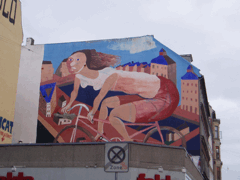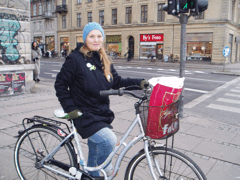City of Cyclists
Air Date: Week of December 18, 2009

Cycling is everywhere in Copenhagen. (Photo: Eileen Bolinsky)
Bicycles are everywhere in Copenhagen. The city invests heavily in this low-tech mode of transportation – with wide bicycle lanes, car-free streets, and special traffic lights, to make cycling safe, easy and fun. Living on Earth’s Eileen Bolinsky took a ride round the streets.
Transcript
CURWOOD: Where the rubber meets the road, it’s usually cars that rule, but in Copenhagen, bicycles are king. More than one in three residents cycle to work or school, making this one of the top cycling cities in the world.
Living on Earth’s Eileen Bolinsky went for a spin.
[SOUNDS OF THE STREET]
BOLINSKY: Bicycles are everywhere in Copenhagen. On the streets, on the subways, leaning against buildings, parked on sidewalks.
KASTRUP: Everyone bicycles in Copenhagen.
BOLINSKY: That’s Marie Kastrup. Cycling’s a huge part of her life; she’s the project manager for the city’s bicycle secretariat.
KASTRUP: So, I bicycle to work everyday, every time I go visit my grandmother I take my bicycle, when I go do my shopping, everything is done by bike.

Marie Castrop bikes everywhere in Copenhagen (Photo: Eileen Bolinsky)
BOLINSKY: Day or night, rain, wind, cold - Copenhageners pedal three-quarters of a million miles each year. But that’s not the way it was before the oil embargo in 1973. Back then just about all of Denmark’s oil came from the Middle East.
KASTRUP: It has to do with the epic public demand in the 70s because of the oil crisis back then, that the politicians in Denmark and Copenhagen started to prioritize cycling and without the massive political investments in cycling, we couldn’t have gotten as far as we are now.
BOLINSKY: You won’t find much spandex or fancy biking gear in this city. Most bikes are sturdy – you might say clunkers – with guards that protect business suits and dresses from a greasy chain. Cycling is simply a part of everyday life here in Denmark.
KASTRUP: It’s just something that you do because it’s the obvious mode of transport. It’s not a part of your identity.
BOLINSKY: It’s definitely not a part of mine, but I wanted to check it out for myself.
KASTRUP: Right now we’re going towards the busiest place in Copenhagen for cyclists. It’s a bridge that connects the medieval center of Copenhagen with the more residential quarters of neighborhoods of Copenhagen.
BOLINSKY: Okay, shall we go?
KASTRUP: Let’s go.
[SOUNDS OF GETTING ON BICYCLE]
BOLINSKY: I haven’t been on a bike in years. In Boston, where I live, the busy streets make biking downright dangerous.
BOLINSKY: Okay, I’m not used to these back brakes. I had them as a kid.
KASTRUP: Just take your time.
BOLINSKY: Getting back on a bike is like, well, getting back on a bike.
Copenhagen’s streets are flat so riding is easy here. There are eight-foot wide bike paths – or tracks – between the sidewalk and parked cars so riders are protected.

(Photo: Eileen Bolinsky)
KASTRUP: Here we have to cross and turn too. First, we have to look out for cyclists.
[SOUNDS OF BUSY INTERSECTION]
BOLINSKY: At a busy intersection, trucks and cars zip by quickly – and so do bicycles. Copenhagen’s city planners are trying a number of experiments to make cycling even faster, safer and easier.
KASTRUP: To the left we can see a piece of the square where we made this experiment with some yellow lines crossing the pavement actually.
BOLINSKY: Usually, it’s illegal for bike riders to cross over a sidewalk. The yellow lines allow cyclists to take a shortcut without a penalty.
KASTRUP: And instead of just handing out a lot of fines we wanted to accommodate these cyclists that really needed a shortcut. And it actually does work. We haven’t seen any accidents between pedestrians and cyclists.
[SOUNDS OF TRAFFIC CONTINUE]
KASTRUP: Another thing we did was to implement green traffic waves for cyclists, which means that you don’t have to stop at red lights at intersections, so the traffic lights are actually following the cyclists instead of the cars.
BOLINSKY: These traffic lights are timed to give priority to bikes during rush hour. 36,000 cyclists pass through this part of town every day.
KASTRUP: Now we will cross the bridge and go out of Norrelbrogade where you can see some more details of the traffic experiments.

Cycling is everywhere in Copenhagen. (Photo: Eileen Bolinsky)
BOLINSKY: Since there are twice as many cyclists as drivers in this part of Copenhagen, some of the streets are closed to cars.
KASTRUP: The cars took up more than two-thirds of the space on the street so we thought why not make the allocation of space reflect the actual use? And so, as you can see we doubled the cycle track which then reduced the space for cars so that there was more space for cyclists and it actually worked.
BOLINSKY: There are 217 miles of bike tracks in Copenhagen, plus 25 miles of tree-lined cycle routes that crisscross in the city center. They’re reserved only for bikes and pedestrians and there are plans for even more.
KASTRUP: In Copenhagen investing in cycling is not just for the bicycles, it’s to make a better city. And in the city center we just have too much congestion if we want to have cars for everyone so the bicycle is a very space economic mode of transport.
BOLINSKY: And people in Copenhagen who choose pedal power are an enthusiastic bunch.
MALE: It’s economical. Its best for our little economy, so we just use the bike.
OLDER WOMAN: It’s easier to get around. Also, it costs a lot of money to take the bus. Then it’s for free and easy.
WOMAN: It’s freedom. You can get anywhere you want in a very short amount of time. And you get exercise, and you get fresh air, and all the good environmental stuff as well.
BOLINSKY: In Copenhagen’s harbor is a statue of the city’s icon – it’s Hans Christian Andersen’s Little Mermaid. But now, the city’s bicycle project manager, Marie Kastrup, says Copenhagen has a new symbol.
KASTRUP: The bicycle girl is this cultural icon in Denmark, it sort of represents this healthy, authentic, happy, active woman, which is a symbol of Denmark. It’s the freedom you can have on a bicycle, and also sort of a healthy, democratic feeling that everyone is free to go on the bicycle and do whatever they want.
BOLINSKY: And what Copenhagen wants is to have half its residents commuting by bicycle in five years.
[SOUNDS OF SQUEAKY BICYCLE]
BOLINSKY: Pedaling the streets of Copenhagen, for Living on Earth, I’m Eileen Bolinsky.
[SOUND OF BICYCLE BELL RINGING TWICE]
Links
Living on Earth wants to hear from you!
Living on Earth
62 Calef Highway, Suite 212
Lee, NH 03861
Telephone: 617-287-4121
E-mail: comments@loe.org
Newsletter [Click here]
Donate to Living on Earth!
Living on Earth is an independent media program and relies entirely on contributions from listeners and institutions supporting public service. Please donate now to preserve an independent environmental voice.
NewsletterLiving on Earth offers a weekly delivery of the show's rundown to your mailbox. Sign up for our newsletter today!
 Sailors For The Sea: Be the change you want to sea.
Sailors For The Sea: Be the change you want to sea.
 The Grantham Foundation for the Protection of the Environment: Committed to protecting and improving the health of the global environment.
The Grantham Foundation for the Protection of the Environment: Committed to protecting and improving the health of the global environment.
 Contribute to Living on Earth and receive, as our gift to you, an archival print of one of Mark Seth Lender's extraordinary wildlife photographs. Follow the link to see Mark's current collection of photographs.
Contribute to Living on Earth and receive, as our gift to you, an archival print of one of Mark Seth Lender's extraordinary wildlife photographs. Follow the link to see Mark's current collection of photographs.
 Buy a signed copy of Mark Seth Lender's book Smeagull the Seagull & support Living on Earth
Buy a signed copy of Mark Seth Lender's book Smeagull the Seagull & support Living on Earth

